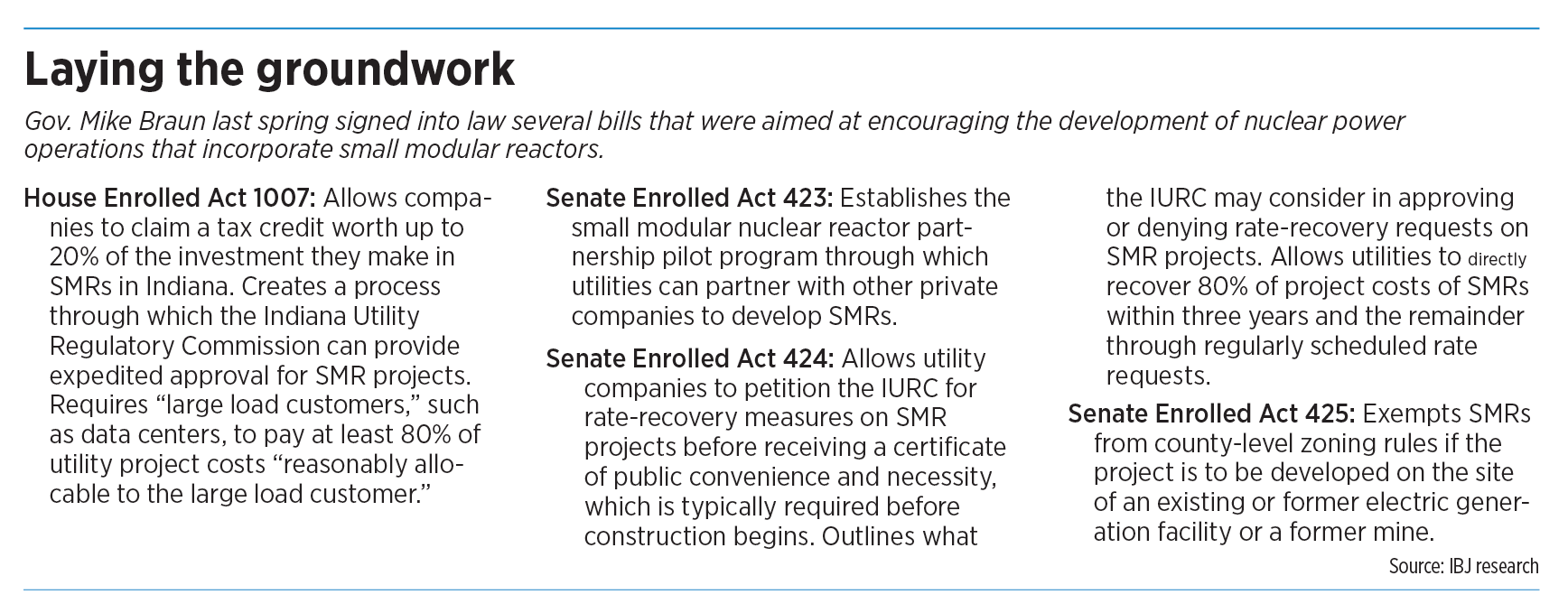Subscriber Benefit
As a subscriber you can listen to articles at work, in the car, or while you work out. Subscribe NowEnergy startup First American Nuclear plans to spend $4 billion and create 5,000 jobs in Indiana in the coming decade as it pursues building a nuclear plant powered by small modular reactors.
The company faces a long road to getting approval for the reactors, the latest technology meant to provide nuclear power in a more affordable and safer way.
But the announcement—which included promises of jobs, investment and eventually power—is exactly the type of headline Republican lawmakers hoped for when they passed a package of nuclear energy-related provisions this spring.
The new laws give tax cuts and other financial incentives to companies and utilities that invest in the reactors, called SMRs. They expedite the approval process for nuclear permitting and let SMR projects bypass county-level zoning laws in certain circumstances.

Taken altogether, the legislation highlights the strategy by legislative Republicans and Gov. Mike Braun to position Indiana as a leader in nuclear energy. This week’s announcement from First American Nuclear is an early win for the initiative.
“They’ve got an exciting, unique technology; it’s great to have a headquarters here in our state,” said Sen. Eric Koch, R-Bedford. “And the jobs that are anticipated are exactly the kind of jobs that we’re looking for: well-paying jobs and 21st century jobs. It’s exactly what we had hoped—but sooner.”
First American Nuclear—which was founded in 1997 and does business as Fanco—says it will move its headquarters from Richland, Washington, to Carmel and build its Closed-Fuel Cycle Nuclear Energy Park somewhere in the state. The park will be the first of its kind in the country, the company said, designed to reprocess and reuse spent nuclear fuel on-site.
Legislative incentives
As chair of the Senate Committee on Utilities, Koch and his House counterpart, Rep. Ed Soliday, R-Valparaiso, authored a series of bills in the 2025 session relating to SMRs.
At the core of the legislative package were Senate Bill 424 and House Bill 1007, which Gov. Mike Braun signed into law. The laws offer energy companies a 20% tax credit for costs related to developing SMRs. Another key provision allows utilities to recover 80% of the costs for approved SMR projects within three years through direct rate increases. The remaining 20% can be recovered through general rate increase requests.
As the bills worked through the Statehouse, Republican leaders emphasized the need to attract more energy generation to Indiana, saying the package of bills would make the state competitive in the reemerging nuclear industry.
As a private company, Fanco could apply for the tax credits but would not benefit from the cost-recovery mechanisms granted to utilities. But Koch said the company was pleased with the overall message that Indiana is open for business in nuclear energy.
“Really starting even before this past session, we had begun setting policy to reposition Indiana relative to nuclear energy,” Koch said. “It does include the tax credit, but it’s more than that.”
Outside the General Assembly, Braun has said making Indiana a national leader in nuclear energy is one of his policy priorities. Braun frequently describes his energy policy as an “all of the above” approach and says nuclear energy will be needed to help Indiana meet the growing demand of AI data centers and advanced manufacturing.
Braun and leaders at Purdue University, which offers a nuclear engineering program, on Wednesday hosted the Global Nuclear Energy Economic Summit in West Lafayette.
Earlier this year, Indiana Michigan Power applied for a $50 million grant from the U.S. Department of Energy to begin officially exploring the possibility of adding an SMR to an I&M coal plant in Rockport that is scheduled to be decommissioned in 2028.
Car manufacturer Rolls Royce, which has a sizable presence in Indiana, is also working on an SMR in the United Kingdom.
But Fanco’s announcement signals further momentum on the nuclear front and brings projected jobs and investment.

Sen. Andy Zay, R-Huntington, who sits on the Senate’s utilities committee, said the nuclear legislation approved this year dovetails into the state’s existing manufacturing emphasis. He emphasized that Fanco is bringing production of its SMR designs to the state.
“Not only will we be hopefully building and utilizing nuclear for future generation, we will also be building the components here with companies like this,” Zay said. “There’s a pretty widely held belief in the industry that nuclear is going to be the way to go, and to be a developer of it and an implementer of it will be a big, big deal for the state of Indiana.”
Other bills passed in the 2025 session include SB 423, which creates a pilot program for utility companies to create business partnerships related to SMR projects, and SB 425, which allows SMR projects to bypass local zoning rules if they are developed on the site of an existing power plant or a mine.
Late last year, Purdue researchers published a study naming eight current and former coal plants in Indiana that could be suitable locations for a small reactor. All of those sites would be covered under SB 425.
SMR skepticism
The recent legislation has its detractors, however, with ratepayer advocates saying the laws place the financial risk of the unproven SMR technology on consumers.

Rep. Matt Pierce, D-Bloomington, the ranking minority member on the House Utilities, Energy and Telecommunications Committee, said he hopes Fanco succeeds. But he’s skeptical about the company’s plans given that no working SMRs exist in North America. In fact, only China and Russia have operational SMR facilities so far.
“If private industry thinks this is a viable technology that could be made affordably—awesome. Invest your private capital, prove your concept, and go out and sell it,” Pierce said. “But all too often, you get speculative ideas of what might work. And then you end up having other people holding the bag, whether they’re ratepayers or the state of Indiana providing some kind of economic development incentives.”
Pierce also said Fanco will likely see local opposition wherever the company attempts to build its energy park given its plans to recycle spent nuclear fuel on-site.

“I don’t know how many people are going to want to have a nuclear waste facility in their backyard,” Pierce said.
A handful of Republicans also voted against the bills. Rep. Andrew Ireland, R-Indianapolis, said in a statement to IBJ that he’s most concerned with making sure the jobs that come with Fanco’s announcement are local hires.
“I firmly believe in an all-of-the-above [energy] strategy but always with common sense and the taxpayer in mind,” Ireland said in the statement. “America needs to lead the world in next-generation energy technology, and Indiana is the right place to build it.
“But here’s what matters most,” added Ireland, who represents the south side of Indianapolis. “Those jobs need to benefit south-side workers and families. That means real investment in our local workforce and training programs to make sure Hoosiers, not foreign or out-of-state hires, fill these positions.”•
Please enable JavaScript to view this content.



